Monthly Updates on Recent Books in the History of Christianity
Due to the cancellation of many conferences in the past months amid the COVID-19 pandemic, many of us have had less opportunity to browse or even see new books coming out in our fields. To raise awareness of recent books in the history of Christianity, the editorial staff of Church History: Studies in Christianity and Culture highlights each month a list of 10-15 books in diverse periods and geographical regions that we hope will be of interest to our members. We include here below the fifth monthly list, chosen by our staff, with excerpts from the publishers’ blurbs.
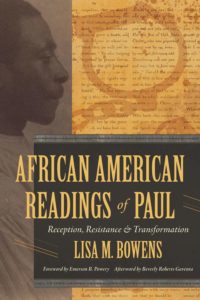
Lisa Bowens, African American Readings of Paul: Reception, Resistance and Transformation. 2020
The letters of Paul—especially the verse in Ephesians directing slaves to obey their masters—played an enormous role in promoting slavery and justifying it as a Christian practice. Yet despite this reality African Americans throughout history still utilized Paul extensively in their own work to protest and resist oppression, responding to his theology and teachings in numerous—often starkly divergent and liberative—ways.
In the first book of its kind, Lisa Bowens takes a historical, theological, and biblical approach to explore interpretations of Paul within African American communities over the past few centuries. She surveys a wealth of primary sources from the early 1700s to the mid-twentieth century, including sermons, conversion stories, slave petitions, and autobiographies of ex-slaves, many of which introduce readers to previously unknown names in the history of New Testament interpretation. Along with their hermeneutical value, these texts also provide fresh documentation of Black religious life through wide swaths of American history. African American Readings of Paul promises to change the landscape of Pauline studies and fill an important gap in the rising field of reception history.
See publisher's website.
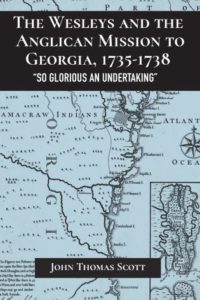
John Thomas Scott, The Wesleys and the Anglican Mission to Georgia, 1735–1738: "So Glorious an Undertaking." 2020
The Wesleys and the Anglican Mission to Georgia, 1735-1738 considers the fascinating early history of a small group of men commissioned by trustees in England to spread Protestantism both to new settlers and indigenous people living in Georgia. Four minister-missionaries arrived in 1736, but after only two years these men detached themselves from the colonial enterprise, and the Mission effectively ended in 1738. Tracing the rise and fall of this endeavor, Scott’s study focuses on key figures in the history of the Mission including the layman, Charles Delamotte, and the ministers, John and Charles Wesley, Benjamin Ingham, and George Whitefield.
In Scott’s innovative historical approach, neglected archival sources generate a detailed narrative account that reveals how these men’s personal experiences and personal networks had a significant impact on the inner-workings and trajectory of the Mission. The original group of missionaries who traveled to Georgia was composed of men already bound together by family relations, friendships, and shared lines of mentorship. Once in the colony, the missionaries’ prospects altered as they developed close ties with other missionaries (including a group of Moravians) and other settlers (John Wesley returned to England after his romantic relationship with Sophy Hopkey soured). Structures of imperialism, class, and race underlying colonial ideology informed the Anglican Mission in the era of trustee Georgia. The Wesleys and the Anglican Mission to Georgia enriches this historical picture by illuminating how a different set of intricacies, rooted in personal dynamics, was also integral to the events of this period. In Scott’s study, the history of the expansive eighteenth-century Atlantic world emerges as a riveting account of life unfolding on a local and individual level.
See publisher's website.
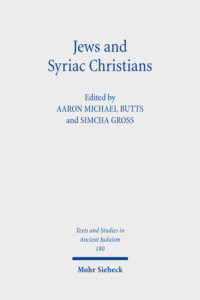
Aaron Michael Butts and Simcha Gross, eds. Jews and Syriac Christians: Intersections across the First Millennium. 2020
Scholarly interest in intersections between Jews and Syriac Christians has experienced a boom in recent years. This is the result of a series of converging trends in the study of both groups and their cultural productions. The present volume contributes to this developing conversation by collecting sixteen studies that investigate a wide range of topics, from questions of origins to the development of communal boundaries, from social interactions to shared historical conditions, involving Jews and Syriac Christians over the first millennium CE. These studies not only reflect the current state of the question, but they also signal new ways forward for future work that crosses disciplinary boundaries between the fields of Jewish Studies and Syriac Studies, in some cases even dismantling those boundaries altogether.
See publisher's website.

Christian Thrue Djurslev, Alexander the Great in the Early Christian Tradition: Classical Reception and Patristic Literature. 2020
What has Alexander the Great to do with Jesus Christ? Or the legendary king's conquest of the Persian Empire (335–23 BCE) to do with the prophecies of the Old Testament?
In many ways, the early Christian writings on Alexander and his legacy provide a lens through which it is possible to view the shaping of the literature and thought of the early church in the Greek East and the Latin West. This book articulates that fascinating discourse for the first time by focusing on the early Christian use of Alexander. Delving into an impressively deep pool of patristic literature written between 130–313 CE, Christian Thrue Djurslev offers original interpretations of various important authors, from the learned lawyer Tertullian to the 'Christian Cicero' Lactantius, and from the apologist Tatian to the first church historian Eusebius. He demonstrates that the early Christian adaptations of the Alexandrian myths created a new tradition that has continued to develop and expand ever since. This innovative work of reception studies is important reading for all scholars of Alexander the Great and early church history.
See publisher's website.
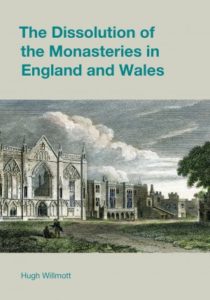
Hugh Willmott, The Dissolution of the Monasteries in England and Wales. 2020
This book provides a timely and original overview of the Dissolution of the Monasteries and its longer term affects on the social and physical landscape of England and Wales during the decades that followed. Combining for the first time the full wealth of archaeological evidence gathered over the last century with the established documentary sources, it takes a more nuanced approach to the understanding of an event that has polarized debates ever since the 16th century.
The book examines the most immediate and destructive outcomes of the Dissolution, such as the ruination and asset stripping of religious property and the dispersal of monastic lands. However, it also presents its longer term, albeit often unexpected outcomes, such as the creation of economic opportunities for individual entrepreneurs and civic authorities, the stimulation of new forms of polite architecture and the development of previously unimagined leisure landscapes. It concludes that whilst the Dissolution had devastating impact upon those in religious orders, its lasting legacy was the remarkable preservation of the country’s medieval Christian heritage through the monuments and archaeological sites that remain to this day in every area of the country.
See publisher's website.

D.H. Williams, Defending and Defining the Faith: An Introduction to Early Christian Apologetic Literature. 2020
In Early Christian Apologetics, D.H. Williams offers a comprehensive presentation of Christian apologetic literature from the second to the fifth century, considering each writer within the intellectual context of the day. Williams argues that most apologies were not directed at a pagan readership. In most cases, he says, ancient apologetics had a double object: to instruct the Christian and to persuade weak Christians or non-Christians who were sympathetic to Christian claims. Traditionally, scholars of apologetics have focused on the context of persecution in the pre-Constantinian period. By following the links in the intellectual trajectory up though the early fifth century, Williams prompts deeper reflection on the process of Christian self-definition in late antiquity. Taken cumulatively, he finds, apologetic literature was in fact integral to the formation of the Christian identity in the Roman world.
See publisher's website.
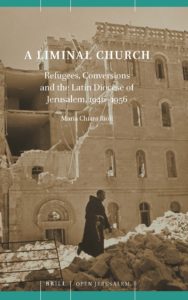
Maria Chiara Rioli, A Liminal Church: Refugees, Conversions and the Latin Diocese of Jerusalem, 1946-1956. 2020
A Liminal Church offers a complex narrative of the Latin patriarchal diocese, commonly portrayed as monolithically aligned with anti-Zionist and anti-Muslim positions during the “long” year of 1948. Making use of largely unpublished archives in the Middle East, Europe and the United States, including the recently released Pius XII papers, Maria Chiara Rioli depicts a church engaged in multiple and sometimes contradictory pastoral initiatives, amid harsh battles, relief missions for Palestinian refugees, theological reflections on Jewish converts to Catholicism, political relations with the Israeli and Jordanian authorities, and liturgical responses to a fluid and uncertain scenario.
The pieces of this history include the Jerusalem grand mufti’s appeal to Pius XII to support the Arab cause, the Catholic liturgies for peace and international mobilization during the Palestine War and Suez crisis, refugees petitioning the patriarch for aid, and Jewish converts establishing Christian kibbutzim. New archival collections and records reveal hidden aspects of the lives of women, children and other silenced actors, faith communities and religious institutions during and after 1948, connecting narratives that have been marginalized by a dominant historiography more focused on military campaigns or confessional conflicts.
A Liminal Church weaves diocesan history with global history. In the momentous decade from 1946 to 1956, the study of the transnational Jerusalem Latin diocese, as split between Israel, Jordan, Egypt and Cyprus, with ties to diaspora and religious international networks and comprising clergy from all over the world, attests to the possibilities of contrapuntal narratives, reintroducing complexity to a deeply and painfully polarized debate, exposing false assumptions and situating changes and ruptures in a long-term perspective.
See publisher's website.
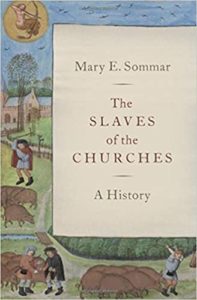
Mary E. Sommar, The Slaves of the Churches: A History. 2020
In recent years, stories of religious universities and institutions grappling with their slave-owning past have made headlines in the news. People find it shocking that the Church itself could have been involved in such a sordid business. This timely book, the result of many years of research, is a study of the origins of this problem.
Mary E. Sommar examines how the church sought to establish norms for slave ownership on the part of ecclesiastical institutions and personnel, and for others' behavior towards such slaves. The story begins in the New Testament era, when the earliest Christian norms were established, and continues up to thirteenth-century establishment of a body of canon law that would persist into the twentieth century. Along with her analysis of the various policies and statutes, Sommar draws on chronicles, letters, and other documents from each of the various historical periods to provide insight into the situations of unfree ecclesiastical dependents. She finds that unfree dependents of the Church actually had less chance of achieving freedom than did the slaves of other masters. The church authorities' duty to preserve the Church's patrimony for the needs of future generations led them to hold on tightly to their unfree human resources. This accessibly written book does not present an apology for the behavior of past Christian leaders, but attempts to learn what they did and to arrive at some understanding of why they made those choices.
See publisher's website.

Andrew M. Selby, Ambrose of Milan’s On the Holy Spirit: Rhetoric, Theology, and Sources. 2020
One might expect that the first pro-Nicene defense of the divinity of the Holy Spirit written in Latin would be lauded. However, Ambrose of Milan's On the Holy Spirit typically has been maligned. This study contradicts this perspective, claiming that Ambrose defines the Holy Spirit in a way consistent with pro-Nicene theology using classical Ciceronian rhetoric to interpret Scripture in a quasi-judicial situation. Instead of viewing Ambrose's On the Holy Spirit through the lens of source-criticism, this study utilizes classical rhetorical theory, especially stasis theory, as a methodology that gives due weight both to the conflict in which Ambrose was embroiled and the bishop's pro-Nicene theological reasoning.
After documenting the ecclesiastical-political conflict that occasioned On the Holy Spirit's composition, this study provides the first comprehensive account of the pneumatology of Ambrose's opponents, the Latin Homoians. Ambrose's own intellectual formation is then investigated, revealing his intimate knowledge of rhetoric and his acquaintance with some philosophical doctrines, both of which factored into the genesis of On the Holy Spirit. Rhetorical analysis of the text uncovers Ambrose's attention to the concerns--theological and political--of his primary audience, the Emperor Gratian. Ambrose used Greek sources, but selected ideas which helped him craft his case. Finally, it is demonstrated that Ambrose used the "definition issue" in stasis theory to understand the Holy Spirit's identity, interpreting Holy Scripture to discover his differentiae from creatures but also his shared propria with the Father and the Son.
See publisher's website.

Marilyn Dunn and Saundra Weddle, eds. Convent Networks in Early Modern Italy. 2020
Interdisciplinary essays that examine the connections of early modern Italian convents, and how these networks were expressed through texts, art, architecture, music, gift and favour exchange, real estate development, and other modes of expression.
The walls of early modern convents suggested the existence of absolute conditions that seldom existed in reality. While the built enclosure communicated the convent’s isolation from the world outside, connections between women religious and individuals or groups outside their communities extended into and from these houses, with each constituency exploiting these associations to serve its own aims. Likewise, the walls conveyed the presence of a homogeneous and unified community where, often, differences in status, power, and other interests led to the development of internal alliances and factions.
Building on an upsurge of scholarly interest in convent networks that previously has not been focused in a single volume, this collection of interdisciplinary essays examines how and why such associations existed. The collection examines personal, spatial, and temporal networks that emerged in, among, and beyond convents in Italy during the early modern period. These ties were established, cultivated, or even rejected in a variety of ways that influenced nuns’ devotional lives, their relationships with patrons, and their cultural engagement and production.
See publisher's website.
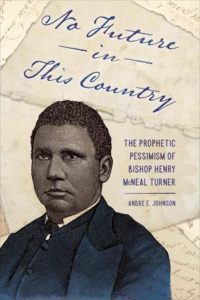
Andre Johnson, No Future in This Country: The Prophetic Pessimism of Bishop Henry McNeal Turner. 2020
University Press of Mississippi
No Future in This Country: The Prophetic Pessimism of Bishop Henry McNeal Turner is a history of the career of Bishop Henry McNeal Turner (1834–1915), specifically focusing on his work from 1896 to 1915. Drawing on the copious amount of material from Turner’s speeches, editorial, and open and private letters, Andre E. Johnson tells a story of how Turner provided rhetorical leadership during a period in which America defaulted on many of the rights and privileges gained for African Americans during Reconstruction. Unlike many of his contemporaries during this period, Turner did not opt to proclaim an optimistic view of race relations. Instead, Johnson argues that Turner adopted a prophetic persona of a pessimistic prophet who not only spoke truth to power but, in so doing, also challenged and pushed African Americans to believe in themselves.
At this time in his life, Turner had no confidence in American institutions or that the American people would live up to the promises outlined in their sacred documents. While he argued that emigration was the only way for African Americans to retain their “personhood” status, he also would come to believe that African Americans would never emigrate to Africa. Turner’s position limited his rhetorical options, but by adopting a pessimistic prophetic voice that bore witness to the atrocities African Americans faced, Turner found space for his oratory, which reflected itself within the lament tradition of prophecy.
See publisher's website.
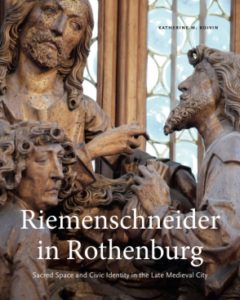
Katherine M. Boivine, Riemenschneider in Rothenburg: Sacred Space and Civic Identity in the Late Medieval City. 2021
The concept of the medieval city is fixed in the modern imagination, conjuring visions of fortified walls, towering churches, and winding streets. In Riemenschneider in Rothenburg, Katherine M. Boivin investigates how medieval urban planning and artistic programming worked together to form dynamic environments, demonstrating the agency of objects, styles, and spaces in mapping the late medieval city.
Using altarpieces by the famed medieval artist Tilman Riemenschneider as touchstones for her argument, Boivin explores how artwork in Germany’s preeminent medieval city, Rothenburg ob der Tauber, deliberately propagated civic ideals. She argues that the numerous artistic pieces commissioned by the city’s elected council over the course of two centuries built upon one another, creating a cohesive structural network that attracted religious pilgrims and furthered the theological ideals of the parish church. By contextualizing some of Rothenburg’s most significant architectural and artistic works, such as St. James’s Church and Riemenschneider’s Altarpiece of the Holy Blood, Boivin shows how the city government employed these works to establish a local aesthetic that awed visitors, raising Rothenburg’s profile and putting it on the pilgrimage map of Europe.
Carefully documented and convincingly argued, this book sheds important new light on the history of one of Germany’s major tourist destinations. It will be of considerable interest to medieval art historians and scholars working in the fields of cultural and urban history.
See publisher's website.
Finally, for staying up-to-date on the latest titles in all fields, we recommend regularly perusing New Books Network, and will regularly link to its “New Books in Christian Studies” page here. These pages are updated regularly.
